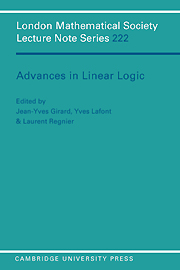Book contents
- Frontmatter
- Contents
- Preface
- Linear Logic: its syntax and semantics
- Part I Categories and semantics
- Part II Complexity and expressivity
- Part III Proof theory
- Part IV Proof nets
- From proof nets to interaction nets
- Empires and kingdoms in MLL-
- Noncommutative proof nets
- Volume of mulitplicative formulas and provability
- Part V Geometry of interaction
Noncommutative proof nets
Published online by Cambridge University Press: 17 February 2010
- Frontmatter
- Contents
- Preface
- Linear Logic: its syntax and semantics
- Part I Categories and semantics
- Part II Complexity and expressivity
- Part III Proof theory
- Part IV Proof nets
- From proof nets to interaction nets
- Empires and kingdoms in MLL-
- Noncommutative proof nets
- Volume of mulitplicative formulas and provability
- Part V Geometry of interaction
Summary
Introduction
The aim of this paper is to give a purely graph-theoretical definition of noncommutative proof nets, i.e. graphs coming from proofs in MNLL (multiplicative noncommutative linear logic, the (⊗, ℘)-fragment of the one-sided sequent calculus for classical noncommutative linear logic, introduced in [Abr91]). Analogously, one of the aims of [Gir87] was to give a purely graph-theoretical definition of proof nets, i.e. graphs coming from the proofs in MLL (multiplicative linear logic, the (⊗, ℘)-fragment of the one-sided sequent calculus for classical linear logic - better, for classical commutative linear logic). - The relevance of the purely graph-theoretical definition of proof nets for the development of commutative linear logic is well-know; thus we hope the results of this paper will be useful for a similar development of noncommutative linear logic.
The language for MNLL is an extension of the language for MLL, obtained simply adding, as atomic formulas, propositional letters with an arbitrary finite number of negations written after the propositional letter (linear post-negation) or before the propositional letter (linear retronegation). Every formula A of MNLL may be translated into a formula Tv(A) of MLL (simply by replacing each propositional letter with an even number of negations by the propositional letter without negations, and each propositional letter with an odd number of negations by the propositional letter with only one negation after the propositional letter).
- Type
- Chapter
- Information
- Advances in Linear Logic , pp. 271 - 296Publisher: Cambridge University PressPrint publication year: 1995
- 10
- Cited by

